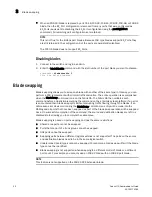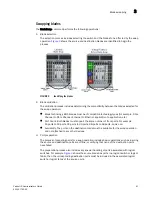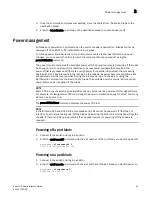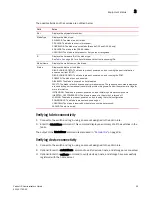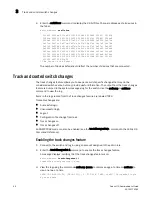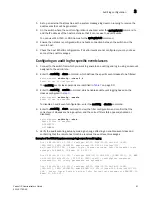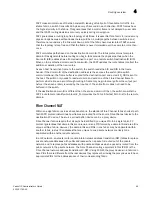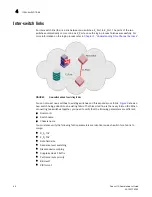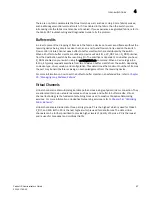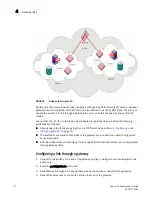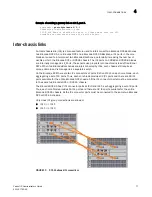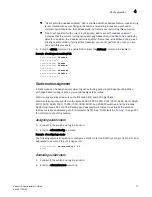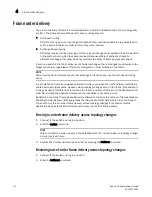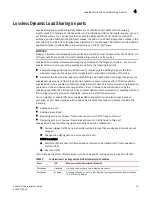
64
Fabric OS Administrator’s Guide
53-1001763-02
Routing overview
4
Path versus route selection
Paths are possible ways to get from one switch to another. Each Inter-Switch Link (ISL) has a metric
cost based on bandwidth. The cumulative cost is based on the sum of all costs of all traversed ISLs.
Route selection is the path that is chosen. Paths that are selected from the routing database are
chosen based on the minimal cost.
FSPF
Fabric Shortest Path First (FSPF) is a link state path selection protocol that directs traffic along the
shortest path between the source and destination based upon the link cost. FSPF is also referred
to as Layer 2 routing. FSPF detects link failures, determines the shortest route for traffic, updates
the routing table, provides fixed routing paths within a fabric, and maintains correct ordering of
frames. FSPF keeps track of the state of the links on all switches in the fabric and associates a cost
with each link. The protocol computes paths from a switch to all the other switches in the fabric by
adding the cost of all links traversed by the path, and chooses the path that minimizes the costs.
This collection of the link states, including costs, of all the switches in the fabric constitutes the
topology database or link state database. Once established, FSPF programs the hardware routing
tables for all active ports on the switch. FSPF is not involved in frame switching. FSPF uses several
frames to perform its functions. Since it may run before fabric routing is set up, FSPF does not use
the routing tables to propagate the frames, but floods the frames throughout the fabric hop-by-hop.
Frames are first flooded on all the ISLs; as the protocol progresses, it builds a spanning tree rooted
on the Principal Switch. Frames are only sent on the Principal ISLs that belong to the spanning tree.
When there are multiple ISLs between switches, the first ISL to respond to connection requests
becomes the Principal ISL. Only one ISL from each switch will be used as the Principal ISL.
Figure 5
shows the thicker red lines as principal ISLs, and thinner green lines as regular ISLs.
FIGURE 5
Principal ISLs
ATTENTION
FSPF only supports 16 ISLs in a zone, including Traffic Isolation Zones.
Summary of Contents for 53-1001763-02
Page 1: ...53 1001763 02 13 September 2010 Fabric OS Administrator s Guide Supporting Fabric OS v6 4 0 ...
Page 4: ...iv Fabric OS Administrator s Guide 53 1001763 02 ...
Page 24: ...xxiv Fabric OS Administrator s Guide 53 1001763 02 ...
Page 28: ...xxviii Fabric OS Administrator s Guide 53 1001763 02 ...
Page 32: ...xxxii Fabric OS Administrator s Guide 53 1001763 02 ...
Page 40: ...xl Fabric OS Administrator s Guide 53 1001763 02 ...
Page 42: ...2 Fabric OS Administrator s Guide 53 1001763 02 ...
Page 54: ...14 Fabric OS Administrator s Guide 53 1001763 02 High availability of daemon processes 1 ...
Page 74: ...34 Fabric OS Administrator s Guide 53 1001763 02 Basic connections 2 ...
Page 102: ...62 Fabric OS Administrator s Guide 53 1001763 02 Audit log configuration 3 ...
Page 214: ...174 Fabric OS Administrator s Guide 53 1001763 02 Management interface security 7 ...
Page 228: ...188 Fabric OS Administrator s Guide 53 1001763 02 Brocade configuration form 8 ...
Page 276: ...236 Fabric OS Administrator s Guide 53 1001763 02 Creating a logical fabric using XISLs 10 ...
Page 404: ...364 Fabric OS Administrator s Guide 53 1001763 02 ...
Page 440: ...400 Fabric OS Administrator s Guide 53 1001763 02 Performance data collection 17 ...
Page 480: ...440 Fabric OS Administrator s Guide 53 1001763 02 F_Port masterless trunking 19 ...
Page 494: ...454 Fabric OS Administrator s Guide 53 1001763 02 Buffer credit recovery 20 ...
Page 574: ...534 Fabric OS Administrator s Guide 53 1001763 02 Hexadecimal overview E ...

